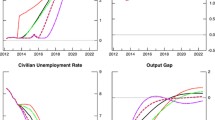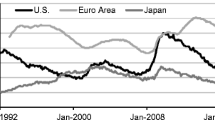Abstract
Regardless of whether the federal funds target rate has lifted off from the zero lower bound, the historical record of interest rates will be forever marred by the lack of variation in the aftermath of the great recession. This paper employs a method of indirect inference to analyze the interplay between unemployment rates, leading indicators and interest rates in an environment with near-zero interest rates. This method is used to estimate a decision tree for state-dependent Federal Reserve policy to estimate an alternative target rate series similar to those predicted by a shadow rate model.






Similar content being viewed by others
Notes
Note that the series changed from a target rate to a range on Dec 16, 2008. A change of 75 b.p. was recorded on that date, measuring the change from the target rate to the lower bound of the range.
Tenfold cross-validation was employed as a countermeasure against overfitting.
References
Baker SR, Bloom N, Davis SJ (2015) Measuring economic policy uncertainty. NBER Working Paper Series 21633, National Bureau of Economic Research
Bauer MD, Rudebusch GD (2016) Monetary policy expectations at the zero lower bound. J Money Credit Bank 50:1439–65
Black F (1995) Interest rates as options. J Finance 50(5):1371–76
Bruins M, Duffy JA, Keane MP, Smith AA (2018) Generalized indirect inference for discrete choice models. J Econom 205(1):177–203
Cavaliere G (2005) Limited time series with a unit root. Econom Theory 21(05):907–945
Cavaliere G (2006) Cointegrated limited time series. Unpublished Manuscript, Societa Itialiana di Statistica
Cavaliere G, Xu F (2014) Testing for unit roots in bounded time series. J Econom 178(2):259–272
Chauvet M (1998) An economic characterization of business cycle dynamics with factor structure and regime switching. Int Econ Rev 39:969–996
Chauvet M, Piger J (2008) A comparison of the real-time performance of business cycle dating methods. J Bus Econ Stat 26:42–49
Christensen JH, Rudebusch GD (2015) Estimating shadow-rate term structure models with near-zero yields. J Financ Econom 13(2):226–259
Claus E, Claus I, Krippner L (2018) Asset market responses to conventional and unconventional monetary policy shocks in the United States. J Bank Finance 97(C):270–282
Gallant A, Tauchen G (2006) Which moment to match. Econom Theory 12(4):657–681
Gouriéroux C, Monfort A, Renault E (1993) Indirect inference. J Appl Econom 8:S85–S118
Gouriéroux C, Phillips P, Yu J (2010) Indirect inference for dynamic panel models. Journal of Econometrics 157(1):68–77
Granger CW (2010) Some thoughts on the development of cointegration. J Econ 158(1):3–6
Guvenen F, Smith A (2014) Inferring labor income risk and partial insurance from economic choices. Econometrica 82(6):2085–2129
Haldrup N, Kruse R, Terasvirta T, Varneskov RT (2013) Unit roots, non-linearities and structural breaks. In: Hashimzade N, Thornton MA (eds) Handbook of research methods and applications in empirical macroeconomics. Edward Elgar Publishing Inc., Northampton, pp 61–94
Hall G, Rust J (2003) Econometric methods for endogenously sampled time series: the case of commodity price speculation in the steel market. Unpublished Manuscript, Yale University
Jeong M (2008) Asymptotics for the maximum likelihood estimation of diffusion models. PhD thesis, Texas A & M University, College Station, TX
Jeong M, Park JY (2013) Asymptotic theory of maximum likelihood estimation of diffusion models. Technical Report
Krippner L (2012) Modifying Gaussian term structure models when interest rates are near the zero lower bound. Reserve Bank of New Zealand Discussion Paper Series DP2012/02, Reserve Bank of New Zealand
Krippner L (2013) A tractable framework for zero lower bound Gaussian term structure models. Reserve Bank of New Zealand Discussion Paper Series DP2013/02, Reserve Bank of New Zealand
Krippner L (2019) A Note of Caution on Shadow Rate Estimates. J Money Credit Bank (Forthcoming)
Morin L (2016) Keeping diffusion processes within bounds: using information between observations. PhD thesis, Queen’s University
Smith A (1990) Three essays on the solution and estimation of dynamic macroeconomic models. PhD thesis, Duke University
Smith A (1993) Estimating nonlinear time-series models using simulated vector autoregressions. J Appl Econom 8:S63–S84
Wu JC, Xia FD (2016) Measuring the macroeconomic impact of monetary policy at the zero lower bound. J Money Credit Bank 48:253–91
Author information
Authors and Affiliations
Corresponding author
Ethics declarations
Conflict of interest
The authors declare that they have no conflict of interest.
Additional information
Publisher's Note
Springer Nature remains neutral with regard to jurisdictional claims in published maps and institutional affiliations.
The authors are grateful for helpful feedback from Edda Claus and from seminar participants at the 2015 annual meeting of the Canadian Economics Association, and from the helpful comments of two anonymous referees, which led to substantial improvements from the original manuscript. All errors are the responsibility of the authors.
Rights and permissions
About this article
Cite this article
Morin, L., Shang, Y. Federal Reserve policy after the zero lower bound: an indirect inference approach. Empir Econ 60, 2105–2124 (2021). https://doi.org/10.1007/s00181-020-01824-4
Received:
Accepted:
Published:
Issue Date:
DOI: https://doi.org/10.1007/s00181-020-01824-4
Keywords
- Federal Reserve
- Target rate
- Zero lower bound
- Classification trees
- Indirect inference
- Simulated minimum distance




